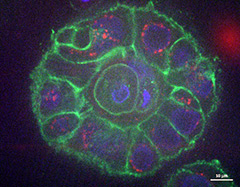Stem cell and skin regeneration

Human stem cells printed using skin printer in order to engineer skin substitutes.
 Human keratinocytes in a mono-layer culture.
Human keratinocytes in a mono-layer culture.We employ different in vitro and in vivo approaches to shed light on the process of wound healing after thermal injuries. We aim to create ideal skin substitutes that can revolutionize the treatment for burn patients. The focus of the group is to reveal the mechanisms leading to (ab)normal wound healing and develop clinically feasible strategies by combining innovative biomaterials and therapeutic cellular components to enable optimized skin regeneration outcomes post-thermal injuries.
Current research interests and projects are as follows:
Development of novel skin substitutes
- development of cell delivery strategies for stem cell-based therapy to treat burn patients in clinical settings
- skin regeneration utilizing wound dressings for burn patients by using microfluidic approaches to deliver skin stem cells and therapeutical biomolecules
- skin regeneration with novel biocompatible synthetic or naturally occurring polymers through in-situ deployed cellularized skin analogue
Ageing-related and (ab)normal wound healing studies
- elucidation of pathways contributing to the impaired wound healings post-thermal injury and exploration of potential measures to restore regeneration capacity
- investigation of underlying mechanisms triggering abnormal healing outcomes involving keloids and HTS as well as novel prevention/treatment strategies
Muscle stem cells response post-thermal injury
- role of satellite cells during muscle catabolism and muscle regeneration post-thermal injury
- the role of metformin in mitigating muscle phenotype post-thermal injury
Liver progenitor cells post thermal injury
- the response of liver progenitor cells post-thermal injury
- the role of myeloid lineage cells during liver fibrosis post-thermal injury


